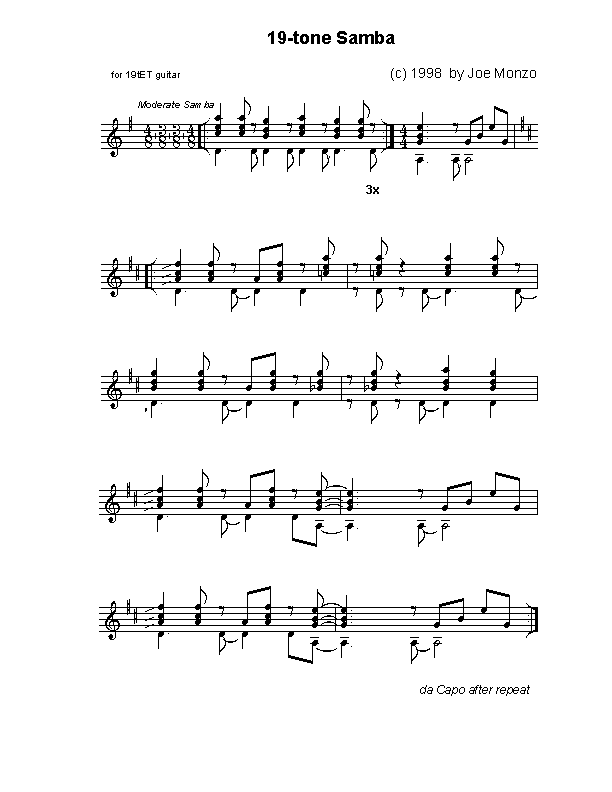19-tone Samba
© 1998 by Joe Monzo
Written November 1998, in San Diego, on one of Ivor Darreg's 19-tone guitars.
(Download the MIDI-file or mp3.)
This piece is in 19-tET tuning, and is an example of a microtonal piece that does not sound xenharmonic at all - to my ears, anyway. (The two terms are often assumed to be synonymous.)
The notational convention follows that used by Neil Haverstick in his book 19 Tones, A New Beginning, but here referenced from 'E' instead of 'C':
19-tET degree Semitones Note (19 12.00 E ) 18 11.37 Eb 17 10.74 D# 16 10.11 D 15 9.47 Db 14 8.84 C# 13 8.21 C 12 7.58 B# 11 6.95 B 10 6.32 Bb 9 5.68 A# 8 5.05 A 7 4.42 Ab 6 3.79 G# 5 3.16 G 4 2.53 Gb 3 1.89 F# 2 1.26 F 1 0.63 E# 0 0.00 E
The piece is very tonal, centered on 'D', and its tuning implies very basic Pythagorean intervals in the bass (it's really almost a drone), diatonic melodic intervals in the top voice, and diatonic and chromatic intervals in the middle voices.
Part of the reason it does not have a 'strange' sound is that it uses only a subset of the entire gamut of pitches, a 9-out-of-19 scale, which is composed of the 'D-major' scale and the two chromatic pitches 'C' and 'Bb'.
19-tET degree Semitones Note 19 12.00 D 17 10.74 C# 16 10.11 C 14 8.84 B 13 8.21 Bb 11 6.95 A 8 5.05 G 6 3.79 F# 3 1.89 E 0 0.00 D
While the "4ths" and "5ths" in this tuning are characteristic of a meantone tuning, the "3rds" and "6ths" imply those of 5-limit JI very well. These are two of the main reasons why the piece sounds so 'ordinary'.
19-tET is nearly identical with 1/3-comma meantone tuning extended to 19 tones.
This piece is very easy to play on a refretted 19-tET guitar, with the open strings tuned as in my diagram. Below is the tablature for 19-tET guitar, for each chord as it appears in the piece.
Intro: Main tune: 2 x 3 2 x ---------- ---------- / \ / \ D9 G A11 Dmaj7 D9 G Gmin Dmaj7 A11 E---8-----5------0---|----3----8----5----5-8-5----3----0---- B---8-----5------0---|----3----8----5----5-5-5----3----0---- G---8-----6------0---|----3----8----6----5-5-5----3----0---- D---0-----0----------|----0----0----0----0-0-0----0--------- A----------------0---|---------------------------------0---- E--------------------|--------------------------------------
(Putting the fingers in the same general places - measured by distance, not by fret-number! - on a regular 12-tET guitar, will result in a performance which sounds very similar to this one. I suppose the same would be true of several other ETs.)
Here's the score of the guitar part (click on it to reload the mp3):
For more info on why 19-tET is such a good and practical approximation allowing 5-limit JI-type harmonic structures, by one of its most illustrious advocates, see my summary of Woolhouse's book.
Updated:
2002.09.28 -- reformatted font of diagrams
2001.07.10
2000.10.22
By Joe Monzo
|
or try some definitions. |
I welcome
feedback about this webpage:
|
